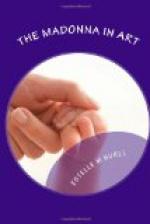It is supposed that he studied under Giovanni Bellini, and at one time was a friend and colleague of Lorenzo Lotto. A child of the mountains—for he was born in Serinalta—he never entirely lost the influence of his early surroundings.
To the last his figures are grave, vigorous, sometimes almost rude, partaking of the characteristics of the everlasting hills. Perhaps it was these traits which made the Santa Conversazione a favorite composition with him. He has an intense love of Nature in her most luxuriant mood.
[Illustration: PALMA VECCHIO.—SANTA CONVERSAZIONE.]
For a collection of Palma’s pictures, we should choose at least four to represent his treatment of the Santa Conversazione: those at Naples, Dresden, Munich, and Vienna. The Naples picture is considered the most successful of Palma’s large pictures of this kind, but it is not easy for the less critical observer to choose a favorite among the four. One general formula describes them all: a sunny landscape with hills clad in their greenest garb; a tree in the foreground, beneath which sits the Virgin, a comely, country-bred matron, who seems to have drawn her splendid vigor from the clear, bright air. On her lap she supports a sprightly little boy, who is the centre of attention.
In the simpler compositions the Madonna is at the left, and at the right kneel or sit two saints. One is a handsome young rustic, unkempt and roughly clad, sometimes figuring as St. John the Baptist, and sometimes as St. Roch. With him is contrasted a beautiful young female saint, usually St. Catherine. Where the composition includes other figures, the Virgin is in the centre, with the attendant personages symmetrically grouped on either side. In the Vienna picture the two additional figures at the left are the aged St. Celestin and a fine St. Barbara.
Of all schools of painting, the Venetian is the least translatable into black and white, so rich in colors is the palette which composed it. This is especially true of Palma, and to understand aright his Santa Conversazione, we must read into it the harmony of colors which it expresses, the chords of blue, red, brown, and green, the shimmering lights and brilliant atmosphere.
[Illustration: FILIPPINO LIPPI.—MADONNA IN A ROSE GARDEN.]
The subject of the Santa Conversazione should not be left without a brief reference to other Venetians, who added to the popularity of this charming style of picture. Berenson mentions seven by Palma’s pupil, Bonifazio Veronese, and one by his friend, Lorenzo Lotto. Cima, Cariani, Paris Bordone, and last, but not least, the great Titian,[3] lent their gifts to the subject, so that we have abundant evidence of the Venetian love of natural scenery.
It remains to consider one more form of the pastoral Madonna, that which represents the Virgin and child in “a garden inclosed,” in allusion to the symbolism of Solomon’s Song (4:12). The subject is found among the woodcuts of Albert Duerer, but I have never seen it in any German painting.




